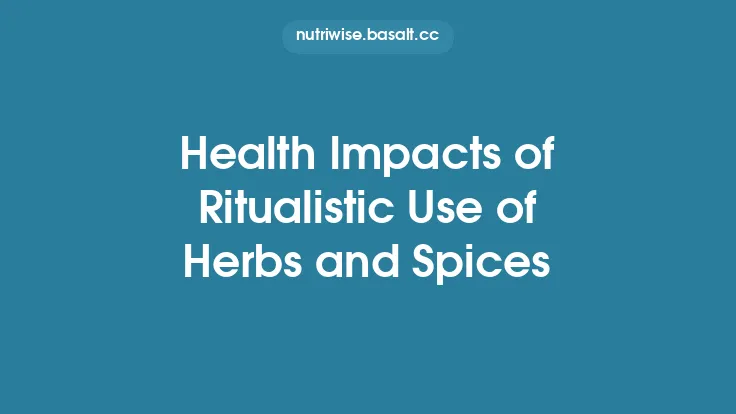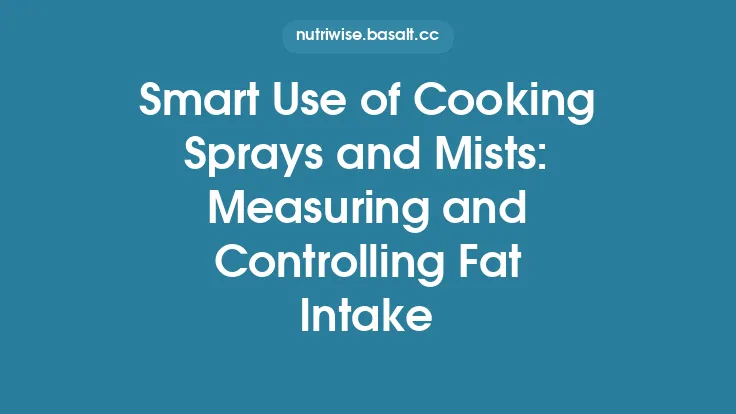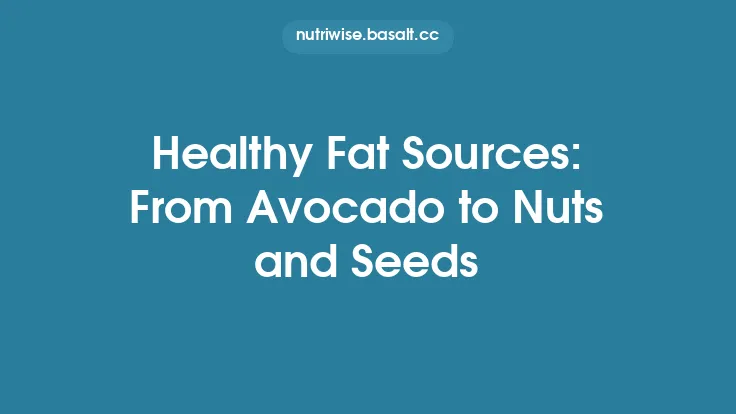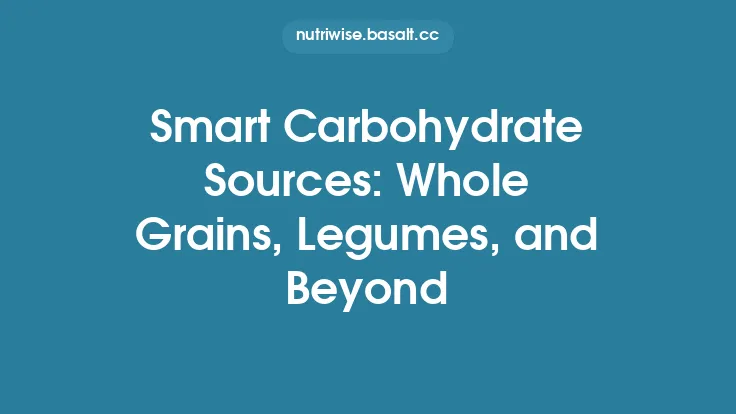Herbs and spices have been treasured across cultures not only for their ability to transform the flavor profile of dishes but also for their potent bioactive compounds that can positively influence cardiovascular health. While the modern kitchen often leans on salt, fat, and sugar to achieve taste, a strategic emphasis on aromatic botanicals offers a low‑calorie, low‑sodium pathway to enhance heart‑friendly meals. This article explores the science behind key herbs and spices, practical culinary applications, and evidence‑based recommendations for integrating them into everyday cooking to support vascular function, blood pressure regulation, lipid balance, and overall heart wellness.
Understanding the Cardiovascular Benefits of Phytochemicals
Polyphenols, Flavonoids, and Alkaloids
Many herbs and spices are rich sources of polyphenols—plant compounds that exhibit antioxidant, anti‑inflammatory, and vasodilatory properties. Flavonoids, a subclass of polyphenols, can improve endothelial function by enhancing nitric oxide (NO) bioavailability, which promotes vessel relaxation and reduces arterial stiffness. Alkaloids such as piperine (found in black pepper) can increase the absorption of other nutrients and bioactives, amplifying their cardiovascular impact.
Mechanistic Pathways
- Antioxidant Defense – Reactive oxygen species (ROS) contribute to oxidative damage of lipids and proteins within arterial walls, accelerating atherosclerosis. Herbs like rosemary and oregano contain rosmarinic acid and carnosic acid, which scavenge ROS and protect low‑density lipoprotein (LDL) particles from oxidation.
- Anti‑Inflammatory Action – Chronic low‑grade inflammation is a hallmark of cardiovascular disease. Curcumin (turmeric) and gingerol (ginger) inhibit nuclear factor‑kappa B (NF‑κB) signaling, reducing the production of pro‑inflammatory cytokines such as interleukin‑6 (IL‑6) and tumor necrosis factor‑α (TNF‑α).
- Blood Pressure Modulation – Certain botanicals influence the renin‑angiotensin‑aldosterone system (RAAS) and sympathetic tone. For example, the flavonoid luteolin in thyme and the potassium content of basil can contribute to modest reductions in systolic and diastolic pressure.
- Lipid Metabolism – Compounds like cinnamaldehyde (cinnamon) and eugenol (cloves) have been shown to up‑regulate hepatic LDL‑receptor expression and enhance cholesterol efflux, supporting healthier lipid profiles.
Herb and Spice Profiles Most Relevant to Heart Health
| Herb/Spice | Key Bioactive(s) | Primary Cardiovascular Effect | Typical Culinary Use |
|---|---|---|---|
| Garlic | Allicin, S‑allyl cysteine | Improves endothelial function; modest BP reduction | Minced in sauces, roasted vegetables |
| Turmeric | Curcumin | Anti‑inflammatory; antioxidant | Added to curries, soups, golden milk |
| Cinnamon | Cinnamaldehyde, polyphenols | Improves insulin sensitivity; lipid modulation | Sprinkled on oatmeal, baked goods |
| Ginger | Gingerol, shogaols | Vasodilation; anti‑platelet | Fresh grated in stir‑fries, teas |
| Rosemary | Carnosic acid, rosmarinic acid | Antioxidant; LDL protection | Infused in marinades, roasted meats |
| Oregano | Carvacrol, thymol | Antioxidant; anti‑inflammatory | Dried in Mediterranean dishes |
| Basil | Eugenol, linalool, potassium | Blood pressure support | Fresh in pesto, salads |
| Thyme | Luteolin, thymol | Anti‑inflammatory; vasodilatory | Dried in stews, rubs |
| Cayenne (capsicum) | Capsaicin | Improves circulation; modest metabolic boost | Powdered in chili, soups |
| Black Pepper | Piperine | Enhances bioavailability of other nutrients | Ground on virtually any savory dish |
| Cloves | Eugenol | Antioxidant; anti‑platelet | Ground in spice blends, desserts |
| Sage | Rosmarinic acid, flavonoids | Antioxidant; anti‑inflammatory | Fresh or dried in stuffing, poultry |
Strategic Pairings: Maximizing Synergy in the Kitchen
The “Golden Duo”: Turmeric + Black Pepper
Piperine in black pepper inhibits hepatic glucuronidation, a metabolic pathway that rapidly deactivates curcumin. Adding a pinch of freshly ground black pepper to turmeric‑based dishes can increase curcumin’s systemic availability by up to 2000 %. For optimal effect, combine ½ tsp turmeric with a pinch (≈¼ tsp) of black pepper and a small amount of healthy fat (e.g., olive oil) to further aid absorption.
Garlic + Citrus
The sulfur compounds in garlic are more stable and bioactive when paired with acidic environments. Squeezing lemon or lime juice over garlic‑infused dressings not only brightens flavor but also helps preserve allicin, enhancing its vasodilatory action.
Ginger + Green Tea
Both ginger and catechins from green tea possess complementary antioxidant mechanisms. Brewing a cup of green tea with a few slices of fresh ginger creates a beverage rich in polyphenols that can support endothelial health and modestly lower blood pressure.
Cinnamon + Apple
Apples provide soluble fiber (pectin) that can bind cholesterol in the gut, while cinnamon improves insulin sensitivity. A warm apple‑cinnamon compote serves as a heart‑friendly dessert that leverages both fiber and spice benefits.
Practical Guidelines for Incorporating Herbs and Spices
1. Start Small, Build Habit
Begin by adding a single new herb or spice to a familiar recipe each week. For instance, sprinkle a quarter teaspoon of dried oregano into a tomato sauce, or stir a pinch of ground ginger into a vegetable stir‑fry. Gradual exposure helps develop palate tolerance and ensures consistent intake of beneficial compounds.
2. Use Fresh When Possible
Fresh herbs often contain higher concentrations of volatile oils compared to dried forms. For maximum potency, add delicate herbs (basil, cilantro, parsley) at the end of cooking or as a garnish. Heat‑stable herbs (rosemary, thyme, sage) can be introduced earlier to allow their flavors to meld.
3. Balance Flavor Profiles
A well‑rounded dish typically includes a balance of aromatic categories:
- Pungent (garlic, ginger, mustard seed) – adds depth and stimulates digestion.
- Sweet/Spicy (cinnamon, clove, cardamom) – provides warmth and can counteract bitterness.
- Herbaceous (basil, dill, mint) – offers freshness and bright acidity.
By combining at least two categories, you achieve complexity without relying on excess salt or fat.
4. Mind the Dosage
While herbs and spices are safe for most people, certain compounds can interact with medications (e.g., warfarin and large amounts of garlic or ginger). General culinary doses—typically ≤1 tsp of dried spice or ≤2 tbsp of fresh herb per serving—are considered safe. Individuals on anticoagulant therapy should consult healthcare providers before dramatically increasing intake.
5. Store Properly to Preserve Potency
- Dried Spices: Keep in airtight containers, away from light, heat, and moisture. Use within 2–3 years; potency declines after 12 months.
- Fresh Herbs: Trim stems, place in a jar with water, cover loosely, and refrigerate. Alternatively, wrap in damp paper towels inside a sealed bag. Use within 5–7 days for optimal flavor.
- Ground Spices vs. Whole: Whole spices (e.g., peppercorns, cinnamon sticks) retain volatile oils longer. Grind just before use for maximum aroma and bioactivity.
Culinary Techniques That Preserve Bioactive Compounds
Low‑Heat Infusion
Gentle simmering (≤90 °C) of herbs like rosemary, thyme, and sage in broth or oil for 10–15 minutes extracts essential oils without degrading heat‑sensitive compounds such as flavonoids. This method is ideal for soups, stews, and infused oils.
Quick Sauté
A brief, high‑heat sauté (30–60 seconds) of garlic, ginger, or chilies in a modest amount of heart‑healthy oil (e.g., extra‑virgin olive oil) activates flavor while preserving allicin and gingerol. Overcooking can cause bitter notes and diminish beneficial properties.
Dry Roasting
Toasting whole spices (cumin seeds, coriander, fennel) in a dry skillet for 1–2 minutes awakens aromatic compounds and enhances antioxidant capacity. Transfer immediately to a cool bowl to prevent continued cooking.
Marination
Acidic marinades (vinegar, citrus juice) combined with herbs and spices allow time‑dependent diffusion of bioactives into proteins. A 30‑minute marination with garlic, rosemary, and lemon juice can infuse chicken or fish with heart‑supportive compounds before cooking.
Evidence‑Based Highlights from Clinical Research
- Garlic: Meta‑analyses of randomized controlled trials (RCTs) demonstrate that standardized garlic extracts can reduce systolic blood pressure by an average of 4–5 mm Hg in hypertensive individuals.
- Turmeric/Curcumin: Studies using bioavailable formulations (e.g., curcumin‑piperine complexes) report improvements in endothelial function measured by flow‑mediated dilation (FMD) after 8–12 weeks of supplementation.
- Cinnamon: Controlled trials in pre‑diabetic populations show modest reductions in fasting glucose and triglycerides, contributing indirectly to cardiovascular risk mitigation.
- Ginger: Acute ingestion of ginger extract (2 g) has been shown to cause a transient reduction in arterial stiffness, as assessed by pulse wave velocity.
- Rosemary: Animal models indicate that rosemary extract can attenuate LDL oxidation and atherosclerotic plaque formation, supporting its antioxidant role.
While many studies focus on isolated extracts, culinary use delivers these compounds within a food matrix, often enhancing tolerability and synergistic effects with other nutrients.
Sample Heart‑Friendly Recipes Showcasing Herbs and Spices
1. Mediterranean Herb‑Infused Baked Salmon
Ingredients
- 4 × 150 g salmon fillets
- 2 tbsp extra‑virgin olive oil
- 1 tsp dried oregano
- 1 tsp dried thyme
- 2 cloves garlic, minced
- Zest of 1 lemon
- Freshly ground black pepper, to taste
Method
- Preheat oven to 190 °C (375 °F).
- In a small bowl, combine olive oil, oregano, thyme, garlic, lemon zest, and pepper.
- Brush the mixture over each salmon fillet.
- Place on a parchment‑lined baking sheet and bake 12–15 minutes, until opaque and flaky.
*Why it works:* Oregano and thyme supply carvacrol and luteolin, while garlic provides allicin—together they support endothelial health without added sodium.
2. Spiced Lentil & Vegetable Stew
Ingredients
- 1 cup red lentils, rinsed
- 1 large carrot, diced
- 1 celery stalk, diced
- 1 onion, chopped
- 2 tbsp tomato paste
- 1 tsp ground cumin
- ½ tsp ground coriander
- ¼ tsp cayenne pepper (optional)
- 1 tsp dried rosemary, crushed
- 4 cups low‑sodium vegetable broth
- 1 tbsp fresh parsley, chopped (for garnish)
Method
- In a pot, sauté onion, carrot, and celery in 1 tbsp olive oil until softened (≈5 minutes).
- Stir in tomato paste, cumin, coriander, cayenne, and rosemary; cook 1 minute.
- Add lentils and broth; bring to a boil, then simmer 20 minutes, or until lentils are tender.
- Adjust seasoning with pepper; serve topped with parsley.
*Why it works:* Cumin and coriander contribute flavonoids that aid lipid metabolism, while rosemary adds antioxidant protection.
3. Warm Apple‑Cinnamon Oatmeal
Ingredients
- ½ cup rolled oats
- 1 cup unsweetened almond milk
- 1 small apple, diced
- ½ tsp ground cinnamon
- ¼ tsp ground cloves
- 1 tbsp chopped walnuts (optional)
Method
- Combine oats, almond milk, apple, cinnamon, and cloves in a saucepan.
- Bring to a gentle boil, then reduce heat and simmer 5–7 minutes, stirring occasionally.
- Transfer to a bowl; top with walnuts for added omega‑3s (if desired).
*Why it works:* Cinnamon’s cinnamaldehyde improves insulin sensitivity, while cloves provide eugenol’s antioxidant benefits.
Safety Considerations and Contraindications
- Allergies: Some individuals may react to specific botanicals (e.g., mustard seed, certain herbs). Introduce new spices gradually and monitor for symptoms.
- Medication Interactions: High doses of garlic, ginger, and turmeric can potentiate the effects of anticoagulants, antiplatelet drugs, and certain antihypertensives. Culinary amounts are generally safe, but patients on these medications should discuss any planned increase with their clinician.
- Pregnancy & Lactation: While most herbs are safe in food‑grade quantities, concentrated supplements (e.g., high‑dose turmeric extracts) should be avoided unless approved by a healthcare professional.
Building a Heart‑Healthy Herb & Spice Pantry
- Core Staples: Garlic, ginger, black pepper, cinnamon, dried oregano, dried thyme, rosemary, and dried basil.
- Specialty Additions: Turmeric, cayenne, cloves, sage, dill, and coriander seeds.
- Fresh Section: Basil, parsley, cilantro, mint, and rosemary (for immediate use).
- Storage Checklist: Airtight glass jars, dark cabinet, label with purchase date, and a small notebook to record flavor experiments and observed health effects.
Monitoring Progress and Adjusting Your Approach
- Track Blood Pressure: Record readings before and after a 4‑week period of increased herb/spice usage to gauge any modest reductions.
- Lipid Panels: Annual lipid profile can reveal trends; note any improvements that coincide with dietary changes.
- Subjective Well‑Being: Pay attention to digestion, energy levels, and cravings. Herbs like ginger and peppermint can also aid gastrointestinal comfort, indirectly supporting heart health by reducing stress‑related eating.
Conclusion
Integrating herbs and spices into everyday cooking is a simple, cost‑effective, and flavorful strategy to bolster cardiovascular wellness. By understanding the bioactive compounds they contain, employing cooking techniques that preserve potency, and pairing them thoughtfully, home cooks can create meals that nourish the heart without relying on excess salt, unhealthy fats, or refined sugars. A well‑stocked pantry, combined with mindful usage, transforms the kitchen into a proactive ally in the lifelong pursuit of a strong, resilient cardiovascular system.





